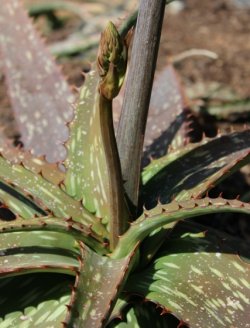Aloe greenii
Aloe greenii Baker
Family: Asphodelaceae
Common names: ground spotted aloe (Eng.); iCeza lesikhotha (isiZulu)
Introduction
Aloe greenii is an excellent rockery plant and makes a good display pot plant in the shade. It has an impressive pink inflorescence that attracts sunbirds. The plant itself is an interesting garden subject throughout the year with its attractive spotted leaves and pink-thorned leaf margins.

Description
Description
Aloe greenii is a low-growing succulent with a flower spike up to 1.3 m tall when in flower (January to March). The individual flowers are about 30 mm long, light to dark pink, in an inflorescence of up to 250 mm.

The 500 x 80 mm leaves grow in a rosette. They are flat at the base and arched in the upper third, with pinkish brown marginal teeth. The stoloniferous rhizomes produce offset suckers that give rise to new plants.

Conservation Status
Status
Aloe greenii is listed as of Least Concern in the Red List of South African plants.
Distribution and habitat
Distribution description
Aloe greenii occurs in sub-tropical coastal forest and adjacent bushveld areas of KwaZulu-Natal as far as Mozambique. In the Ndumo area it grows in well-drained sandy soils in association with Huernia hystrix and Stapelia gigantea under Vangueria infausta canopy forest. It is easily confused with other spotted aloes such as Aloe maculata, A. pruinosa, and A. parvibracteata when not in flower.
Derivation of name and historical aspects
History
The generic name Aloe is derived from the Greek aloe for the bitter sap obtained from aloe leaves (known as alloeh in Arabic, and allal in Hebrew).
Ecology
Ecology
The spotted leaves are well-camouflaged in the dappled, shaded habitat in which it occurs. ICeza produces stoloniferous offsets that give rise to new plants. At Kirstenbosch National Botanical Garden it is visited by sunbirds when in flower.

Uses
Use
The sap of aloe leaves is commonly used in Zulu traditional medicine for cleansing ceremonies and to treat livestock. Aloes are also used for iNtelezi (protective charms) to ward off evil spirits. While there are no specific recorded traditional or cultural uses for A. greenii, aloes are used interchangeably for these purposes depending on which species is locally available.
Growing Aloe greenii
Grow
At Kirstenbosch National Botanical Garden we cultivate A. greenii in both full sun and partial shade. We do not get much seed-set, so we propagate it mainly vegetatively from root offsets, but I have noticed that the inflorescence sometimes produces vegetative plantlets. According to resident succulent specialist at Kirstenbosch NBG, Dr. Ernst van Jaarsveld, this has also been observed in other aloes and is a survival strategy.
References
- Germishuizen, G. & Meyer, N.L. (eds). 2003. Plants of southern Africa: an annotated checklist. Strelitzia 14. National Botanical Institute. Pretoria
- Pooley, E. 1998. A field guide to wild flowers of KwaZulu-Natal and the Eastern Region . Natal Flora Publications Trust, Durban
- Victor, J.E. & Von Staden, L. 2008. Aloe greenii Baker. National Assessment: Red List of South African Plants version 2012.1. Accessed on 2012/09/02
Credits
Phakamani Xaba
Kirstenbosch NBG
September 2012
Plant Attributes:
Plant Type: Succulent
SA Distribution: KwaZulu-Natal
Soil type:
Flowering season: Late Summer
PH:
Flower colour: Pink
Aspect: Morning Sun (Semi Shade), Afternoon Sun (Semi Shade)
Gardening skill: Easy
Special Features:
Horticultural zones









Rate this article
Article well written and informative
Rate this plant
Is this an interesting plant?
Login to add your Comment
Back to topNot registered yet? Click here to register.